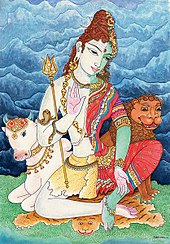Shaivism
Shivaism or Shaivism (from Sanskrit शैव Śaiva [ˈʃaiʋʌ] "belonging to Shiva") includes those directions of Hinduism in which Shiva has the central role as the highest deity and universal being, who towers above all other gods and lets them emerge from himself, as does the entire universe. Shivaism is a form of religion in which God is thought of as simultaneously immanent and transcendent.
In religious practice and philosophical teachings, Shivaism is not a unified form of religion. A distinction is made between epic-puranic Shivaism, which is Vedic-Brahmanic and folk-religious in orientation, and esoteric-sectarian Shivaism, which requires initiation and in which Brahmins are in the minority.
Thus the mythical Shiva of the Puranas plays no role in sects of esoteric Shivaism, but Shiva appears here as transcendent and, as in the Kashmiri Shaivas, also as monistic, the aim of this religion being liberation (salvation) and sometimes the acquisition of Siddhis. In contrast, in the Tamil Shaiva-Siddhanta, for example, Shiva is seen as a personal deity, and Moksha as identification with the personal God.
In addition to cultic Shivaism, there is also a devotional and poetic Shivaism that developed in the wake of certain mystics, such as the movement of the Lingayats or Vira Shaivas.
The Dashanami Sampradaya (see Hindu Orders), founded by Shankara in the 8th century CE, is also counted by many among the Shaivas, and some subgroups are clearly Shaivas. The philosophical orientation of these groups is primarily monistic, similar to Kashmiri Shivaism. Thus the main scripture of the Juna Akhada, the Avadhuta Gita, is a radically monistic work.
While Vishnuism is mainly focused on the loving union of man and God (see Bhakti), some directions of Shivaism put great emphasis on the possibility of man becoming one with God. Some directions see salvation in the attainment of a Shiva-like state and perpetual contact with it. Most Shivaite groups accept as valid a philosophical-theological system that recognizes three eternal principles: Pati, the Lord (Shiva), Pashu, the cattle (the individual soul), and Pasha, the bondage (matter and karma). In order to come into contact with Shiva, Atman (cf. soul) must free itself from the fetters of karma and matter and become similar to the state of Shiva, i.e., approach his power and knowledge and escape the possibility of suffering.
There are numerous different Shivaite groupings, and many of them practice teachings of yoga and tantra. Strict antinomian asceticism is also common, for example among the Kalamukhas and Kapalikas. The movement of ascetic Natha yogis, whose origin is unclear, seems to incorporate elements of Buddhism. The goal of the Natha yogis is to reach the state of sahaja samadhi, in which the yogi is at one with the universe in complete tranquility and removed from all earthly things, and is at the same time Shiva, Shakti, teacher, disciple, meditator, meditation object and meditator.
Shivaism includes both differentiated cultic actions and complex philosophical-theological systems (cf. Samkhya), which can only be presented here in simplified form. A Shivaite literature developed, comprising twenty-eight orthodox Agamas and about two hundred additional texts. A major textual source is the Puranas. Esoteric Shivaism refers to the Agamas and Tantras.
Shivaism has millions of followers in India and thousands of temples and monasteries. Along with Shaktism and Vishnuism, it is one of the three main branches of Hinduism, and there is also the Indian folk religion. Today it is particularly popular in South India and in Kashmir.

Shiva as Ardhanarishvara

Shiva statue
History
Early Shivaism borrowed its theology from that of the Vishnuites. Its early forms arose among priests of Yajurveda. From the 4th century it only developed into an independent direction. The heyday of Shivaism began in the 9th century and from the 10th century onwards, temple complexes still in existence today were established in southern and central India. The main schools of Shivaism from the 10th century onwards are Kashmiri Shivaism, Shaiva-Siddhanta, the Natha-Yogis and the Virashaivas. The heyday of Shivaism lasted till the 13th century.

Sadhu during Shivaratri
The mythological Shiva of the Puranas
In the Shivaite cults, Shiva is the supreme being who surpasses all other gods in power and also created them. The beings and the world are subject to change, only Shiva alone is imperishable, eternal and the fullness of the absolute. He is the primordial source of existence. He bears various names testifying to His greatness such as Mahadeva (the Great God), Ishvara (the Lord), Maheshvara (the Great Lord), Prameshvara (the Supreme Lord). However, despite his function as an absolute existence and all-god, the myths always show him also as a terrible god and a great ascetic who indulges in excruciating mortifications and is attached to nature. He is the spirit (Purusha), the essence of the whole manifested world (Prakriti) and the motive power of that world. To him alone it is reserved to make the world come into being and pass away. After the end of the world periodically brought about by him, nothing remains but Shiva himself, and cyclically he creates new universes through the Maya of his Yoga, out of which arises the lotus, from which Brahma emerges. The whole universe is conceived as arising from and passing into the dance of Shiva Nataraja. His dance sustains the world and redeems the souls. He performs his dance surrounded by gods in the Himalayas, as a ten-armed being surrounded by demons and Devi on mortuary grounds and in the golden halls of the Nataraja temple of Chidambaram, the centre of the universe. His dance symbolizes his fivefold qualities of evolution: sustaining, contracting, enshrouding (souls in samsara), graciously accepting devotees, and bestowing peace and salvation. He contains as absolutes the paradoxes of untamed, savage and cruel nature and supreme wisdom and deepest peace. In many representations the god is worshipped as half female, half male as Ardhanarishvara, who is one with his Shakti, his feminine side.
Search within the encyclopedia